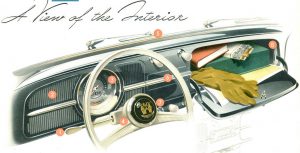 My first car was a Volkswagen. It was a 1960 model bought in Hamburg in 1967, and it carried me without a hitch as far as Valencia (which is where it was stolen, but that’s another story). I’d never driven a VW before, but the simple controls required no advance knowledge. The only gauge was a large speedometer that included an odometer, turn indicators, and two (unidentified) warning lights, one for oil pressure and one for the alternator/generator. A third warning light lit up when the gas tank was empty, which required flipping a switch to access the reserve tank (about a gallon, or 40 miles)—there was no gas gauge. There was no temperature gauge because the engine was air-cooled. In addition, the dashboard included two white pull-knobs; the left was for lights and the right for the windshield wiper. I think there was a choke knob somewhere.
My first car was a Volkswagen. It was a 1960 model bought in Hamburg in 1967, and it carried me without a hitch as far as Valencia (which is where it was stolen, but that’s another story). I’d never driven a VW before, but the simple controls required no advance knowledge. The only gauge was a large speedometer that included an odometer, turn indicators, and two (unidentified) warning lights, one for oil pressure and one for the alternator/generator. A third warning light lit up when the gas tank was empty, which required flipping a switch to access the reserve tank (about a gallon, or 40 miles)—there was no gas gauge. There was no temperature gauge because the engine was air-cooled. In addition, the dashboard included two white pull-knobs; the left was for lights and the right for the windshield wiper. I think there was a choke knob somewhere.
I was reminded of my VW the other day when a friend offered my a ride in his new Prius. The digital read-outs of what Toyota calls the Multi-Information Display, covered a range of technical information such as low tire pressure and fuel consumption, and included such extraneous information as which door was open. Basically, the traditional gauges were replaced by a small computer screen, and like most personal computer screens, it was awash in icons, numbers, and information. Since the marginal cost of adding more information is minimal, I got the sense that the designers had simply piled on the bells and whistles. No doubt one gets used to it in time, but I would miss the minimalist elegance of my old VW.

A friend let me help drive his brand new VW bug from Texas to Chicago in 1962. I was surprised by how solid the body was, how fun it was to drive, and how comfortable. The experience greatly raised my respect for German cars, one of which I now drive.